Performance Improvement of GaN Based Laser Diode Using Pd/Ni/Au Metallization Ohmic Contact
Abstract
1. Introduction
2. Experiments
2.1. Thin p Electrode Metal Films Fabrication
2.2. Annealing of p Electrode Metal Thin Films
2.3. p Electrode Metal Thin Films Characterization
3. Results and Discussion
3.1. Multi-Element Metal Alloy
3.2. The Effect of Ni and Pd Thickness in Pd/Ni/Au
3.3. The Effect of KOH Pretreatment
3.4. Performance Improvement of GaN Laser Power by Pd/Ni/Au Metallization
4. Conclusions
Author Contributions
Funding
Acknowledgments
Conflicts of Interest
References
- Nakamura, S.; Senoh, M.; Nagahama, S.I.; Iwasa, N.; Yamada, T.; Matsushita, T.; Kiyoku, H.; Sugimoto, Y.; Kozaki, T.; Umemoto, H.; et al. InGaN/GaN/AlGaN-based laser diodes with modulation-doped strained-layer superlattices grown on an epitaxially laterally overgrown GaN substrate. Appl. Phys. Lett. 1998, 72, 211–213. [Google Scholar] [CrossRef]
- Schmidt, M.C.; Kim, K.C.; Farrell, R.M.; Feezell, D.F.; Cohen, D.A.; Saito, M.; Fujito, K.; Speck, J.S.; DenBaars, S.P.; Nakamura, S. Demonstration of nonpolar m-plane InGaN/GaN laser diodes. Jpn. J. Appl. Phys. 2007, 46, L190–L191. [Google Scholar] [CrossRef]
- Chi, Y.C.; Hsieh, D.H.; Tsai, C.T.; Chen, H.Y.; Kuo, H.C.; Lin, G.R. 450-nm GaN laser diode enables high-speed visible light communication with 9-Gbps QAM-OFDM. Opt. Express 2015, 23, 13051–13059. [Google Scholar] [CrossRef]
- Nakamura, S.; Mukai, T.; Senoh, M. High-power GaN pn junction blue-light-emitting diodes. Jpn. J. Appl. Phys. 1991, 30, L1998–L2001. [Google Scholar] [CrossRef]
- Guha, S.; Bojarczuk, N.A. Ultraviolet and violet GaN light emitting diodes on silicon. Appl. Phys. Lett. 1998, 72, 415–417. [Google Scholar] [CrossRef]
- Nakamura, S.; Mukai, T.; Senoh, M. Candela class high brightness InGaN/AlGaN double heterostructure blue light emitting diodes. Appl. Phys. Lett. 1994, 64, 1687–1689. [Google Scholar] [CrossRef]
- Yonkee, B.P.; Young, E.C.; DenBaars, S.P.; Nakamura, S.; Speck, J.S. Silver free III-nitride flip chip light-emitting-diode with wall plug efficiency over 70% utilizing a GaN tunnel junction. Appl. Phys. Lett. 2016, 109, 191104. [Google Scholar] [CrossRef]
- Wu, Y.F.; Kapolnek, D.; Ibbetson, J.P.; Parikh, P.; Keller, B.P.; Mishra, U.K. Very-high power density AlGaN/GaN HEMTs. IEEE Trans. Electron Devices 2001, 48, 586–590. [Google Scholar] [CrossRef]
- Kizilyalli, I.C.; Edwards, A.P.; Aktas, O.; Prunty, T.; Bour, D. Vertical power pn diodes based on bulk GaN. IEEE Trans. Electron Devices 2015, 62, 414–422. [Google Scholar] [CrossRef]
- Su, Y.K.; Chiou, Y.Z.; Juang, F.S.; Chang, S.J.; Sheu, J.K. GaN and InGaN metal-semiconductor-metal photodetectors with different Schottky contact metals. Jpn. J. Appl. Phys. 2001, 40, 2996–2999. [Google Scholar] [CrossRef]
- Chen, Q.; Khan, M.A.; Sun, C.J.; Yang, J.W. Visible-blind ultraviolet photodetectors based on GaN pn junctions. Electron. Lett. 1995, 31, 1781–1782. [Google Scholar] [CrossRef]
- Li, K.H.; Fu, W.Y.; Cheung, Y.F.; Wong, K.K.Y.; Wang, Y.; Lau, K.M.; Choi, H.W. Monolithically integrated InGaN/GaN light-emitting diodes, photodetectors, and waveguides on Si substrate. Optica 2018, 5, 564–569. [Google Scholar] [CrossRef]
- Ng, H.M.; Doppalapudi, D.; Korakakis, D.; Singh, R.; Moustakas, T.D. MBE growth and doping of III–V nitrides. J. Cryst. Growth 1998, 189, 349–353. [Google Scholar] [CrossRef]
- Trexler, J.T.; Pearton, S.J.; Holloway, P.H.; Mier, M.; Evans, K.; Karlicek, R. Comparison of Ni/Au, Pd/Au, Cr/Au metallizations for ohmic contacts to p-GaN. MRS Online Proc. Libr. Arch. 1996, 449, 1091–1096. [Google Scholar] [CrossRef]
- Voss, L.; Khanna, R.; Pearton, S.J.; Ren, F.; Kravchenko, I. Improved thermally stable ohmic contacts on p-GaN based on W2B. Appl. Phys. Lett. 2006, 88, 012104. [Google Scholar] [CrossRef]
- Chang, K.M.; Chu, J.Y.; Cheng, C.C. Investigation of indium–tin-oxide ohmic contact to p-GaN and its application to high-brightness GaN-based light-emitting diodes. Solid-State Electron. 2005, 49, 1381–1386. [Google Scholar] [CrossRef]
- Chen, L.C.; Chen, F.R.; Kai, J.J.; Chang, L.; Ho, J.K.; Jong, C.S.; Chiu, C.C.; Huang, C.N.; Chen, C.Y.; Shih, K.K. Microstructural investigation of oxidized Ni/Au ohmic contact to p-type GaN. J. Appl. Phys. 1996, 86, 3826–3832. [Google Scholar] [CrossRef]
- Chen, L.C.; Ho, J.K.; Jong, C.S.; Chiu, C.C.; Shih, K.K.; Chen, F.R.; Kai, J.J.; Chang, L. Oxidized Ni/Pt and Ni/Au ohmic contacts to p-type GaN. Appl. Phys. Lett. 2000, 76, 3703–3705. [Google Scholar] [CrossRef]
- Oh, M.S.; Hwang, D.K.; Lim, J.H.; Kang, C.G.; Park, S.J. Low resistance nonalloyed Ni/Au Ohmic contacts to p-GaN irradiated by KrF excimer laser. Appl. Phys. Lett. 2006, 89, 042107. [Google Scholar] [CrossRef]
- Zhou, L.; Lanford, W.; Ping, A.T.; Adesida, I.; Yang, J.W.; Khan, A. Low resistance Ti/Pt/Au ohmic contacts to p-type GaN. Appl. Phys. Lett. 2000, 76, 3451–3453. [Google Scholar] [CrossRef]
- Kim, J.K.; Lee, J.L.; Lee, J.W.; Eoi Shin, H.; Jo Park, Y.; Kim, T. Low resistance Pd/Au ohmic contacts to p-type GaN using surface treatment. Appl. Phys. Lett. 1998, 73, 2953–2955. [Google Scholar] [CrossRef]
- Kumakura, K.; Toshiki, M.; Naoki, K. Low-resistance nonalloyed ohmic contact to p-type GaN using strained InGaN contact layer. Appl. Phys. Lett. 2001, 79, 2588–2590. [Google Scholar] [CrossRef]
- Jang, J.S.; Park, S.J.; Seong, T.Y. Metallization scheme for highly low-resistance, transparent, and thermally stable ohmic contacts to p-GaN. Appl. Phys. Lett. 2000, 76, 2898–2900. [Google Scholar] [CrossRef]
- Kwak, J.S.; Nam, O.H.; Park, Y. Temperature-dependent contact resistivity of the nonalloyed ohmic contacts to p-GaN. J. Appl. Phys. 2004, 95, 5917–5919. [Google Scholar] [CrossRef]
- Kwak, J.S.; Cho, J.; Chae, S.; Choi, K.; Sung, Y.; Lee, S.; Nam, O.H.; Park, Y. Carrier transport mechanism of Pd/Pt/Au ohmic contacts to p-GaN in InGaN laser diode. Phys. Status Solidi A 2002, 194, 587–590. [Google Scholar] [CrossRef]
- Chu, C.F.; Yu, C.C.; Wang, Y.K.; Tsai, J.Y.; Lai, F.I.; Wang, S.C. Low-resistance ohmic contacts on p-type GaN using Ni/Pd/Au metallization. Appl. Phys. Lett. 2000, 77, 3423–3425. [Google Scholar] [CrossRef]
- Feng, M.; Sun, Q.; Liu, J.; Li, Z.; Zhou, Y.; Gao, H.; Zhang, S.; Yang, H. Al-free cladding-layer blue laser diodes with a low aspect ratio in far-field beam pattern. J. Semicond. 2018, 39, 084004. [Google Scholar] [CrossRef]
- Shan Hsu, P.; Hardy, M.T.; Wu, F.; Koslow, I.; Young, E.C.; Romanov, A.E.; Fujito, K.; Feezell, D.F.; DenBaars, S.P.; Speck, J.S.; et al. 444.9 nm semipolar (1122) laser diode grown on an intentionally stress relaxed InGaN waveguiding layer. Appl. Phys. Lett. 2012, 100, 021104. [Google Scholar] [CrossRef]
- Feng, M.; Wang, J.; Zhou, R.; Sun, Q.; Gao, H.; Zhou, Y.; Liu, J.; Huang, Y.; Zhang, H.; Ikeda, M.; et al. On-chip integration of gan-based laser, modulator, and photodetector grown on Si. IEEE J. Sel. Top. Quantum Electron. 2018, 24, 1–5. [Google Scholar] [CrossRef]
- Ishikawa, H.; Kobayashi, S.; Koide, Y.; Yamasaki, S.; Nagai, S.; Umezaki, J.; Koike, M.; Murakami, M. Effects of surface treatments and metal work functions on electrical properties at p-GaN/metal interfaces. J. Appl. Phys. 1997, 81, 1315–1322. [Google Scholar] [CrossRef]
- Lee, J.L.; Kim, J.K.; Lee, J.W.; Park, Y.J.; Kim, T. Effect of surface treatment by KOH solution on ohmic contact formation of p-type GaN. Solid-State Electron. 1999, 43, 435–438. [Google Scholar] [CrossRef]
- Lee, J.L.; Weber, M.; Kim, J.K.; Lee, J.W.; Park, Y.J.; Kim, T.; Lynn, K. Ohmic contact formation mechanism of nonalloyed Pd contacts to p-type GaN observed by positron annihilation spectroscopy. Appl. Phys. Lett. 1999, 74, 2289–2291. [Google Scholar] [CrossRef][Green Version]
- Song, J.O.; Leem, D.S.; Kwak, J.S.; Nam, O.H.; Park, Y.; Seong, T.Y. High-quality nonalloyed rhodium-based ohmic contacts to p-type GaN. Appl. Phys. Lett. 2003, 83, 2372–2374. [Google Scholar] [CrossRef]
- Sun, J.; Rickert, K.A.; Redwing, J.M.; Ellis, A.B.; Himpsel, F.J.; Kuech, T.F. p-GaN surface treatments for metal contacts. Appl. Phys. Lett. 2000, 76, 415–417. [Google Scholar] [CrossRef]
- Pearton, S.J.; Zolper, J.C.; Shul, R.J.; Ren, F. GaN: Processing, defects, and devices. J. Appl. Phys. 1999, 86, 1–78. [Google Scholar] [CrossRef]
- Lee, J.L.; Kim, J.K. Ohmic contact formation mechanism of Pd nonalloyed contacts on p-type GaN. J. Vac. Sci. Technol. B 2000, 147, 2667–2670. [Google Scholar] [CrossRef][Green Version]
- Lee, C.S.; Lin, Y.J.; Lee, C.T. Investigation of oxidation mechanism for ohmic formation in Ni/Au contacts to p-type GaN layers. Appl. Phys. Lett. 2001, 79, 3815–3817. [Google Scholar] [CrossRef]
- Li, X.; Zhao, D.G.; Jiang, D.S.; Yang, J.; Chen, P.; Liu, Z.S.; Zhu, J.J.; Liu, W.; He, X.G.; Li, X.J.; et al. Analysis of localization effect in blue-violet light emitting InGaN/GaN multiple quantum wells with different well widths. Chin. Phys. B 2017, 26, 017805. [Google Scholar] [CrossRef]
- Weimar, A.; Lell, A.; Brüderl, G.; Bader, S.; Harle, V. Investigation of low-resistance metal contacts on p-type GaN using the linear and circular transmission line method. Phys. Status Solidi A 2001, 183, 169–175. [Google Scholar] [CrossRef]
- Marlow, G.S.; Das, M.B. The effects of contact size and non-zero metal resistance on the determination of specific contact resistance. Solid-State Electron. 1982, 25, 91–94. [Google Scholar] [CrossRef]
- Cho, H.K.; Hossain, T.; Bae, J.W.; Adesida, I. Characterization of Pd/Ni/Au ohmic contacts on p-GaN. Solid-State Electron. 2005, 49, 774–778. [Google Scholar] [CrossRef]
- Jang, J.S.; Chang, I.S.; Kim, H.K.; Seong, T.Y.; Lee, S.; Park, S.J. Low-resistance Pt/Ni/Au ohmic contacts to p-type GaN. Appl. Phys. Lett. 1999, 74, 70–72. [Google Scholar] [CrossRef]
- Jang, H.W.; Kim, K.H.; Kim, J.K.; Hwang, S.; Yang, J.J.; Lee, K.J. Low-resistance and thermally stable ohmic contact on p-type GaN using Pd/Ni metallization. Appl. Phys. Lett. 2001, 79, 1822–1824. [Google Scholar] [CrossRef]
- Jang, J.S.; Park, S.J.; Seong, T.Y. Interfacial reaction of Ni/Pt/Au contact schemes to p-type GaN. J. Electrochem. Soc. 1999, 146, 3425–3428. [Google Scholar] [CrossRef]
- Jang, H.W.; Son, J.H.; Lee, J.L. Formation of high-quality Ag-based ohmic contacts to p-type GaN. J. Electrochem. Soc. 2008, 155, H563–H568. [Google Scholar] [CrossRef]
- Qin, Z.X.; Chen, Z.Z.; Zhang, H.X.; Ding, X.M.; Hu, X.D.; Yu, T.J.; Zhang, G.Y. The role of Ni and Au on transparent film of blue LEDs. Solid-State Electron. 2005, 47, 1741–1743. [Google Scholar] [CrossRef]
- Yonkee, B.P.; Young, E.C.; Lee, C.; Leonard, J.T.; Denbaars, S.P.; Speck, J.S.; Nakamura, S. Demonstration of a III-nitride edge-emitting laser diode utilizing a GaN tunnel junction contact. Opt. Express 2016, 24, 7816–7822. [Google Scholar] [CrossRef]
- Myzaferi, A.; Reading, A.H.; Farrell, R.M.; Cohen, D.A.; Nakamura, S.; Denbaars, S.P. Semipolar III-nitride laser diodes with zinc oxide cladding. Opt. Express 2017, 25, 16922–16930. [Google Scholar] [CrossRef]
- Lee, J.L.; Wei, L.; Tanigawa, S.; Oigawa, H.; Nannichi, Y. Evidence for the passivation effect in (NH4)2Sx-treated GaAs observed by slow positrons. Appl. Phys. Lett. 1991, 58, 1167–1169. [Google Scholar] [CrossRef]
- Chor, E.F.; Zhang, D.; Gong, H.; Chen, G.L.; Liew, T.Y.F. Electrical characterization and metallurgical analysis of Pd-containing multilayer contacts on GaN. J. Appl. Phys. 2001, 90, 1242–1249. [Google Scholar] [CrossRef]
- Zhang, A.P.; Luo, B.; Johnson, J.W.; Ren, F.; Han, J.; Pearton, S.J. Role of annealing conditions and surface treatment on ohmic contacts to p-GaN and p-Al0.1Ga0.9N/GaN superlattices. Appl. Phys. Lett. 2001, 79, 3636–3638. [Google Scholar] [CrossRef]
- Logan, R.A.; Thurmond, C.D. Heteroepitaxial thermal gradient solution growth of GaN. J. Electrochem. Soc. 1972, 119, 1727–1735. [Google Scholar] [CrossRef]

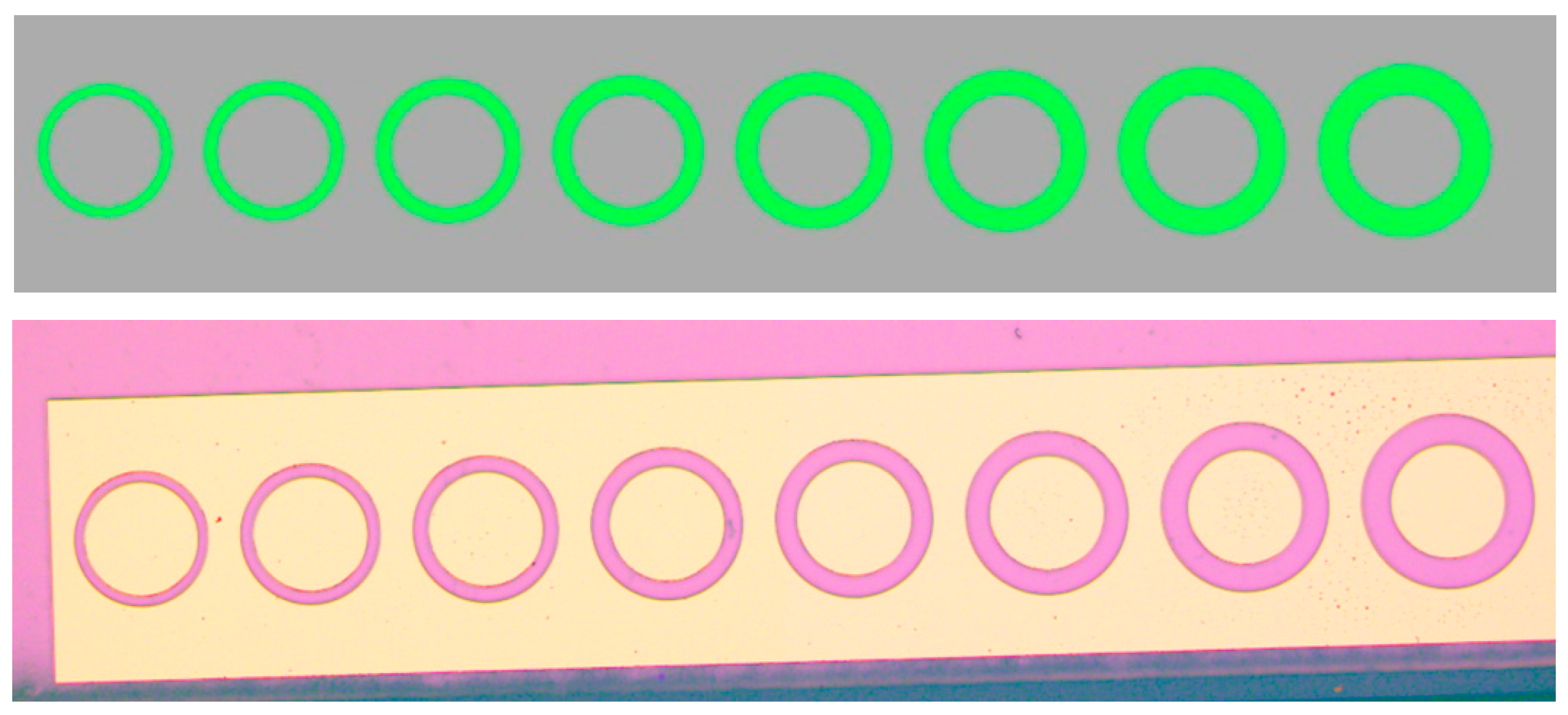
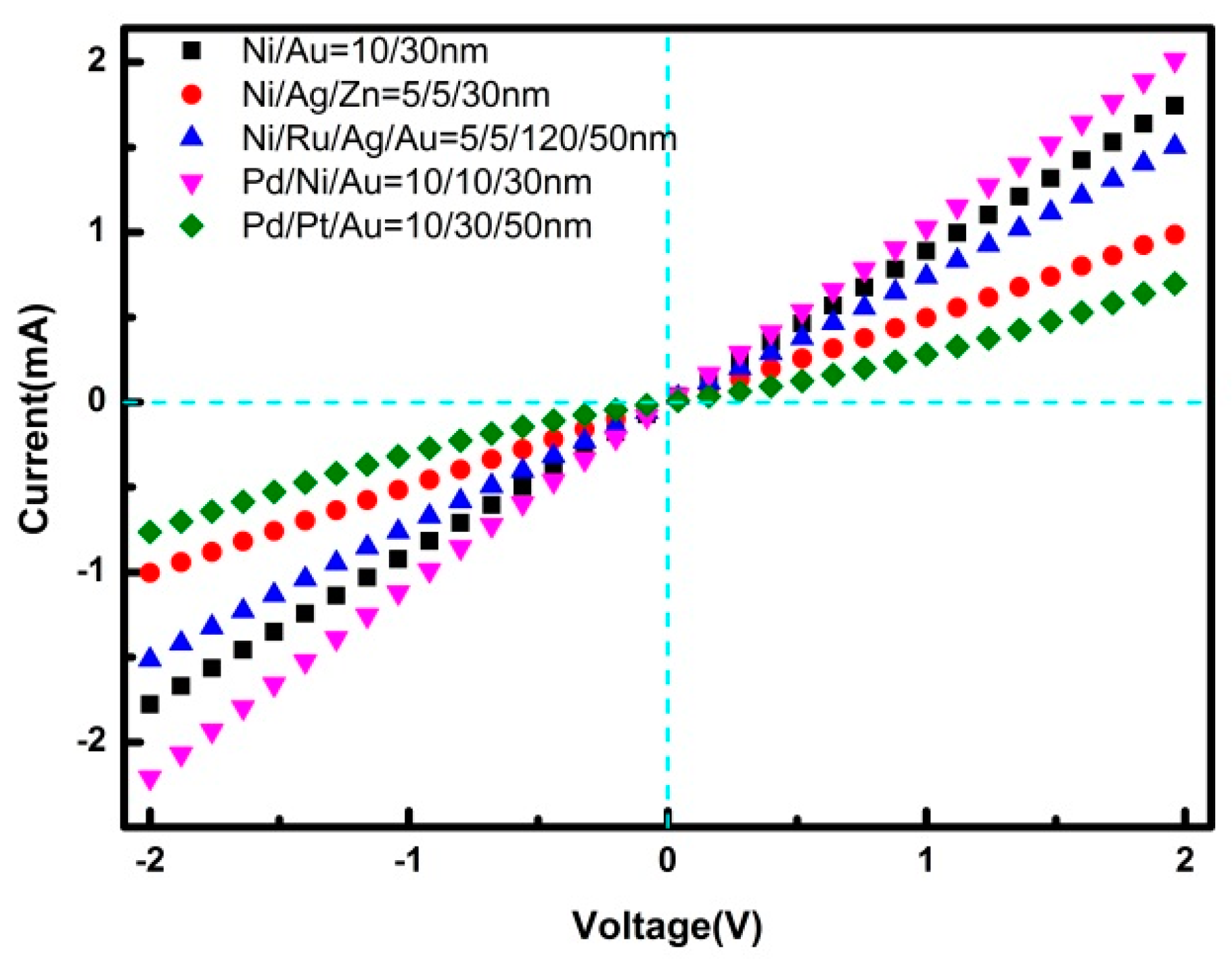

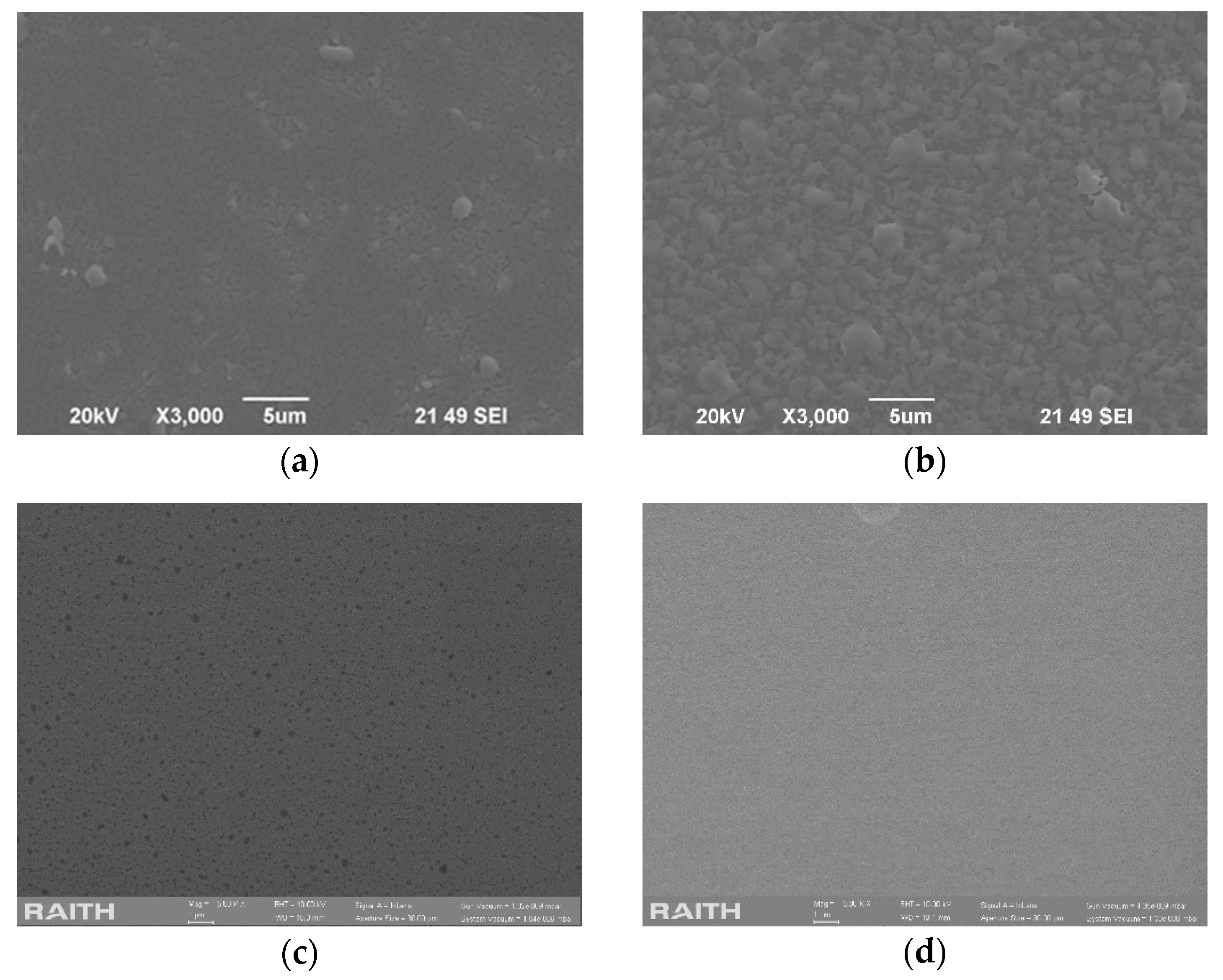

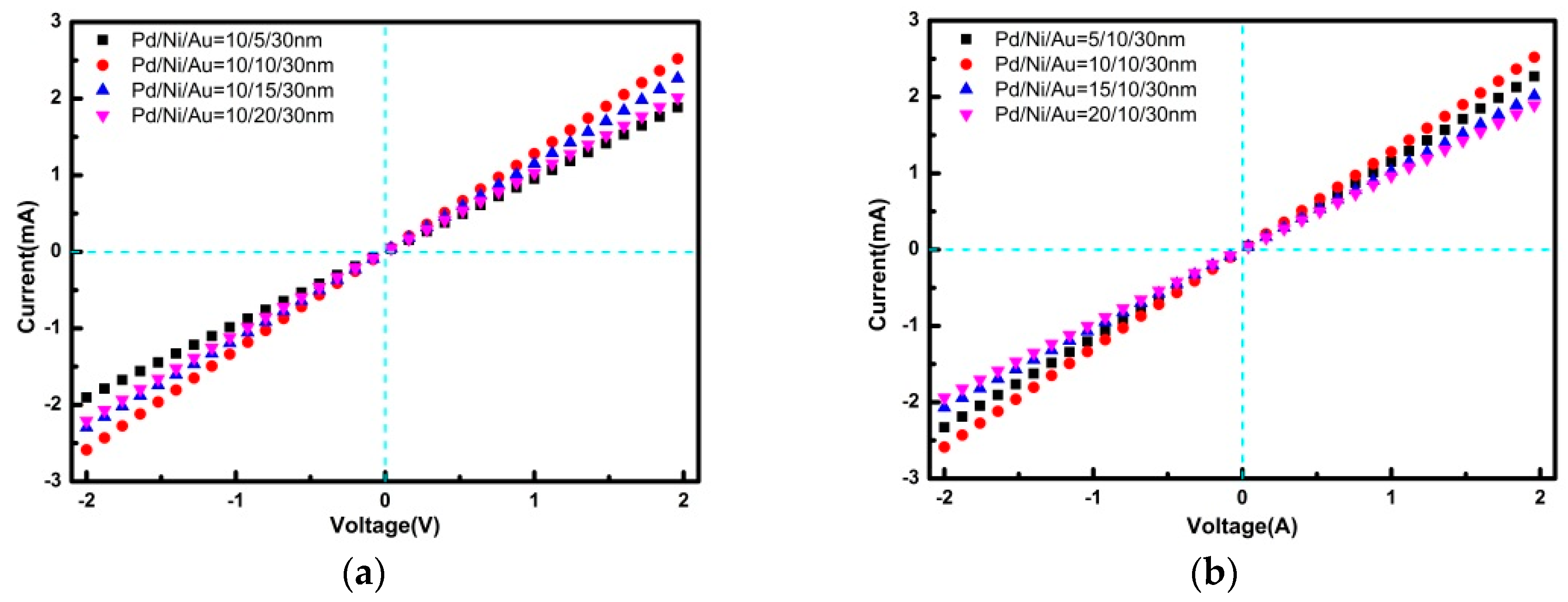

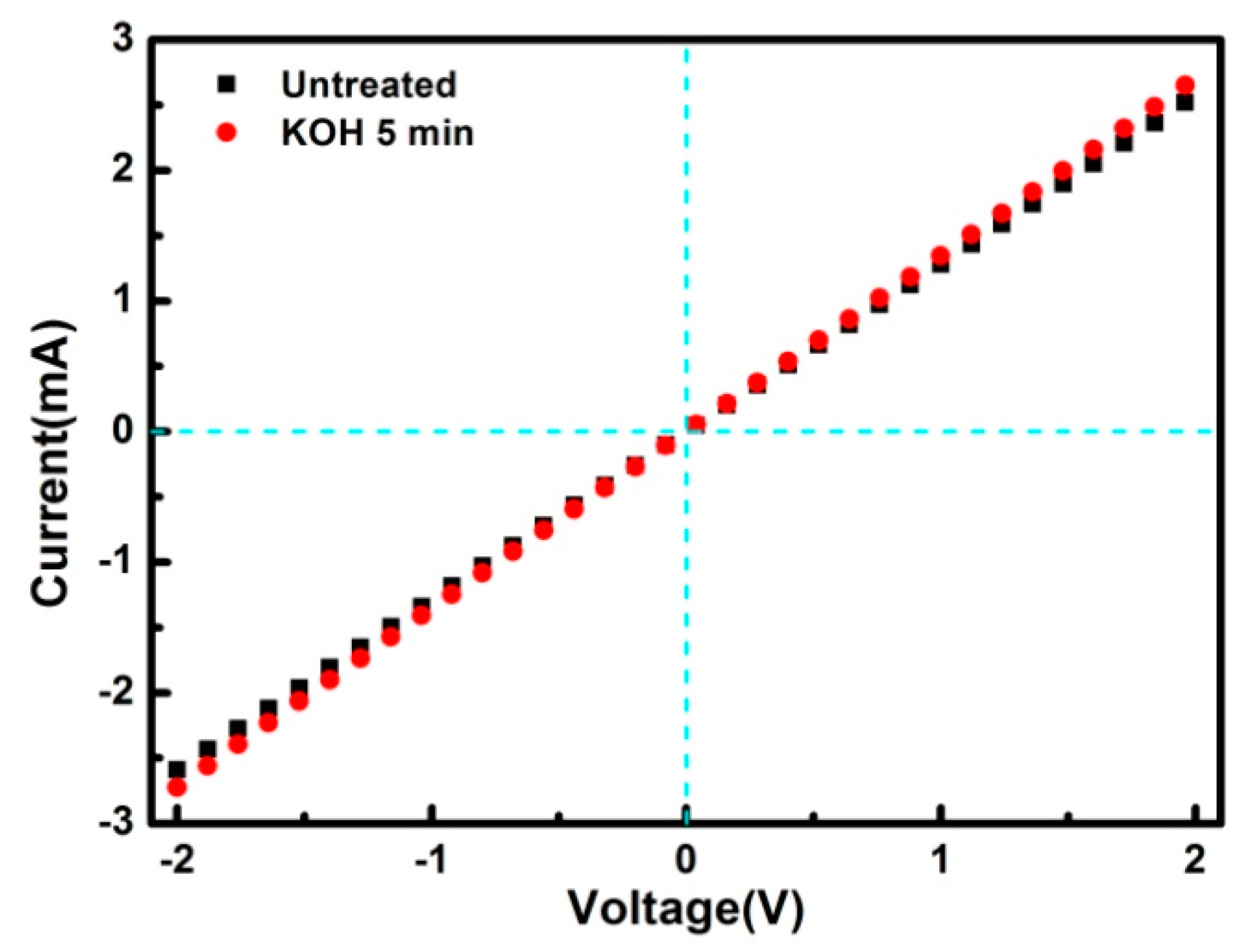
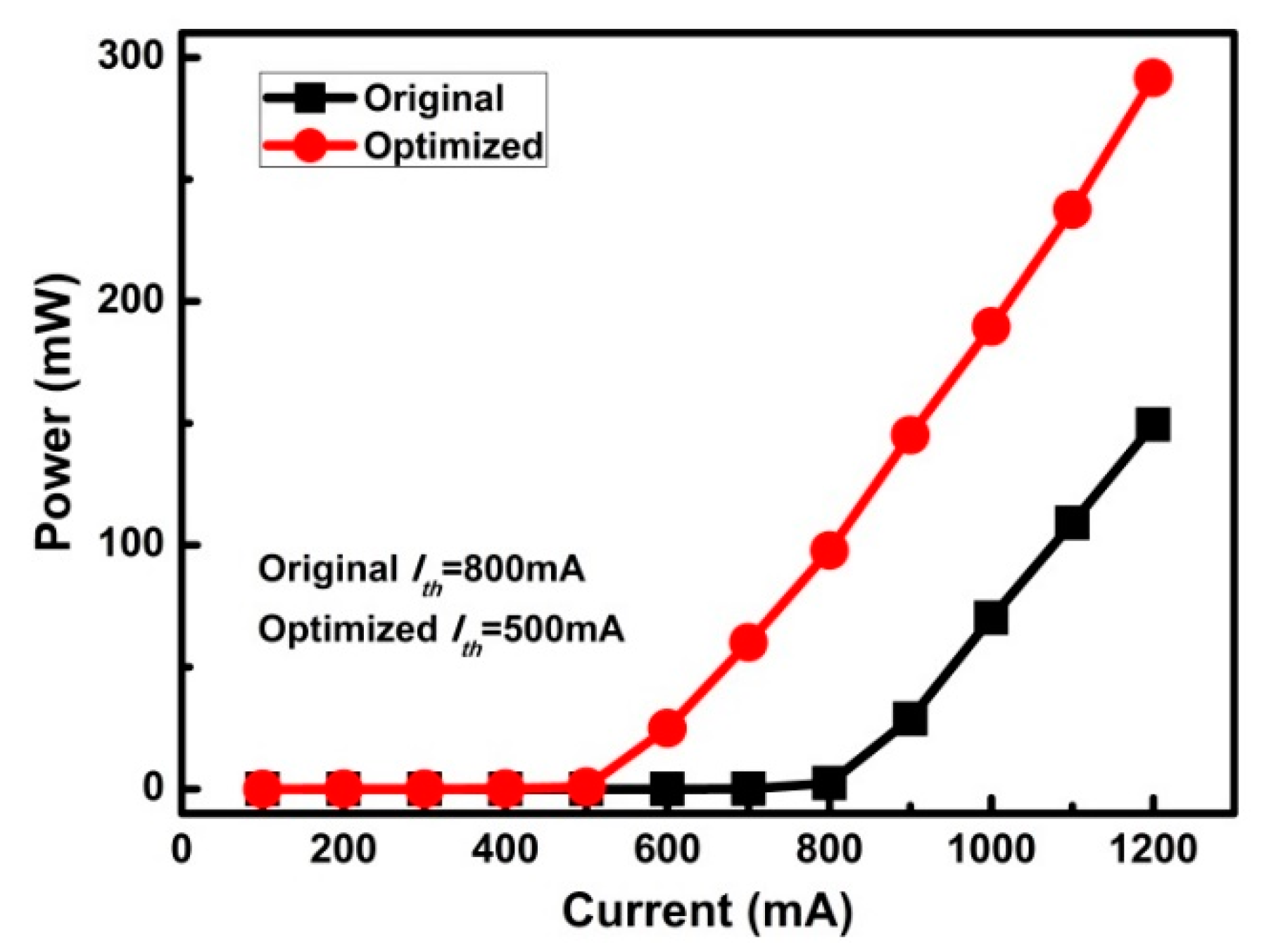
| Film Structure | Growth Rate | Annealing Temperature | Annealing Ambient |
|---|---|---|---|
| Ni/Au = 10/30 nm Ni/Au = 15/15 nm Ni/Au = 15/30 nm Ni/Au = 15/50 nm | Ni = 0.1 nm/s Au = 0.2 nm/s | 520 °C | N2:O2 = 4:1 |
| Ni/Ag/Zn = 5/120/30 nm | Ni = 0.1 nm/s Ag = 0.3 nm/s Zn = 0.2 nm/s | 500 °C | N2:O2 = 4:1 |
| Ni/Ru/Ag/Au = 5/5/120/50 nm | Ni = 0.1 nm/s Ru = 0.1 nm/s Ag = 0.3 nm/s Au = 0.2 nm/s | 520 °C | N2:O2 = 4:1 |
| Pd/Ni/Au = 10/10/30 nm | Pd = 0.1 nm/s Ni = 0.1 nm/s Au = 0.2 nm/s | 520 °C | N2:O2 = 4:1 |
| Pd/Pt/Au = 10/30/50 nm | Pd = 0.1 nm/s Pt = 0.1 nm/s Au = 0.2 nm/s | 520 °C | N2 |
| Film Structure | Annealing Temperature | Annealing Ambient | Specific Contact Resistances | Error |
|---|---|---|---|---|
| Ni/Au = 10/30 nm Ni/Au = 15/15 nm Ni/Au = 15/30 nm Ni/Au = 15/50 nm | 520 °C | N2:O2 = 4:1 | 7.5 × 10−3 Ω·cm2 6.4 × 10−4 Ω·cm2 4.3 × 10−3 Ω·cm2 8.4 × 10−3 Ω·cm2 | (−2.9,4.1) × 10−3 Ω·cm2 (−3.1,4.2) × 10−4 Ω·cm2 (−3.1,4.2) × 10−3 Ω·cm2 (−3.3,4.1) × 10−3 Ω·cm2 |
| Ni/Ag/Zn = 5/120/30 nm | 500 °C | N2:O2 = 4:1 | 3.6 × 10−2 Ω·cm2 | (−0.3,0.5) × 10−2 Ω·cm2 |
| Ni/Ru/Ag/Au = 5/5/120/50 nm | 520 °C | N2:O2 = 4:1 | 2.8 × 10−3 Ω·cm2 | (−0.8,3.7) × 10−3 Ω·cm2 |
| Pd/Ni/Au = 10/10/30 nm | 520 °C | N2:O2 = 4:1 | 7.3 × 10−5 Ω·cm2 | (−2.3,3.3) × 10−5 Ω·cm2 |
| P Electrode | Annealing Temperature | Annealing Ambient | RMS |
|---|---|---|---|
| Ni/Au Pd/Ni/Au | non | non | <1 nm |
| Ni/Au | 520 °C | N2:O2 = 4:1 | 13.64 nm |
| Pd/Ni/Au | 520 °C | N2:O2 = 4:1 | 1.75 nm |
| Film Structure | Annealing Temperature | Annealing Ambient | Specific Contact Resistances | Error |
|---|---|---|---|---|
| Pd/Ni/Au = 5/10/30 nm Pd/Ni/Au = 10/10/30 nm Pd/Ni/Au = 15/10/30 nm Pd/Ni/Au = 20/10/30 nm Pd/Ni/Au = 10/5/30 nm Pd/Ni/Au = 10/15/30 nm Pd/Ni/Au = 10/20/30 nm | 520 °C | N2:O2 = 4:1 | 7.6 × 10−4 Ω·cm2 7.3 × 10−5 Ω·cm2 1.8 × 10−4 Ω·cm2 2.1 × 10−4 Ω·cm2 4.1 × 10−4 Ω·cm2 1.3 × 10−4 Ω·cm2 2.5 × 10−4 Ω·cm2 | (−3.5,4.7) × 10−4 Ω·cm2 (−2.3,3.3) × 10−5 Ω·cm2 (−1.5,2.7) × 10−4 Ω·cm2 (−1.6,2.7) × 10−4 Ω·cm2 (−1.7,3.0) × 10−4 Ω·cm2 (−1.5,2.7) × 10−4 Ω·cm2 (−1.6,2.7) × 10−4 Ω·cm2 |
© 2019 by the authors. Licensee MDPI, Basel, Switzerland. This article is an open access article distributed under the terms and conditions of the Creative Commons Attribution (CC BY) license (http://creativecommons.org/licenses/by/4.0/).
Share and Cite
Wang, W.; Xie, W.; Deng, Z.; Yang, H.; Liao, M.; Li, J.; Luo, X.; Sun, S.; Zhao, D. Performance Improvement of GaN Based Laser Diode Using Pd/Ni/Au Metallization Ohmic Contact. Coatings 2019, 9, 291. https://doi.org/10.3390/coatings9050291
Wang W, Xie W, Deng Z, Yang H, Liao M, Li J, Luo X, Sun S, Zhao D. Performance Improvement of GaN Based Laser Diode Using Pd/Ni/Au Metallization Ohmic Contact. Coatings. 2019; 9(5):291. https://doi.org/10.3390/coatings9050291
Chicago/Turabian StyleWang, Wenjie, Wuze Xie, Zejia Deng, Haojun Yang, Mingle Liao, Junze Li, Xiaojia Luo, Song Sun, and Degang Zhao. 2019. "Performance Improvement of GaN Based Laser Diode Using Pd/Ni/Au Metallization Ohmic Contact" Coatings 9, no. 5: 291. https://doi.org/10.3390/coatings9050291
APA StyleWang, W., Xie, W., Deng, Z., Yang, H., Liao, M., Li, J., Luo, X., Sun, S., & Zhao, D. (2019). Performance Improvement of GaN Based Laser Diode Using Pd/Ni/Au Metallization Ohmic Contact. Coatings, 9(5), 291. https://doi.org/10.3390/coatings9050291





